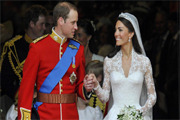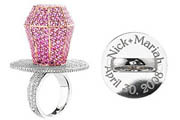Now, we’re not suggesting that any of you kids out there go and get married – marriage happens to most of us later in life, when we’re grown up, mature and have had some time to really discover ourselves and decide what we want from our lives. But maybe your older sister or brother is getting married soon or you’re just wondering where some of those strange traditions you see at most weddings come from… lucky you! We’ve got all the wedding trivia you would ever want (or need) to know.
June Bride
Ever heard the term "June bride"? It refers to the fact more people get married in June than any other month. Contrary to popular belief, this tradition did NOT come about because of the dependable weather. Actually, there are a number of interesting reasons J-U-N-E spells "marriage."
For instance, some classical scholars believe the month of June is actually named after Juno, the Roman goddess of marriage. Fast-forward a few centuries and you'll find another good reason to book a banquet hall for June: according to one old wives' tale, "Marry in the month of May, and you'll surely rue the day. Marry when June roses grow, over land and sea you'll go."
Bridesmaid Blues
Bridesmaids' dresses: they're not just evil looking, they're evil-repellent. The reason bridesmaids all dress the same is actually because, in ancient Rome, several of the 10 witnesses required to make a wedding legal would dress identically to the bride and groom to confuse any evil spirits that might crash the ceremony. (Unfortunately, this doesn't explain why bridesmaids' dresses are so ugly…)
Ring Thing
Blame Greece (the civilization - not the film starring John Travolta) for the reason North Americans put their weddings rings on the third finger of their left hands. Ancient Greeks believed a vein in this finger ran directly to the heart.
And all those guys whose wallets are hurting after having to buy their fiancées an engagement ring and a wedding band, they can blame Pope Innocent III. In the 13th century, Innocent instituted a waiting period between engagement and marriage, and insisted a ring be used in the wedding ceremony. Before that, rings were only used to seal an engagement (as well as other important agreements).
Sealed With a Kiss
In ancient Rome, a kiss - considered legally binding - was used to seal a contract. And later on, a bride marrying in the Church of England had to plant one on the minister before she could smooch her groom! I don't know about you, but I'd personally love to go to a wedding where the minister said, "Now I may kiss the bride."
French Toast
When we drink to someone, we call it a "toast" because of an old French custom where a piece of bread was placed at the bottom of the wine cup for flavour. In France, partygoers would drink and pass the cup; when it reached the person being toasted, he would drain it - crouton and all.
Final Fling
Many things are thrown through the air at weddings: rice (for fertility), bouquets (for luck and protection) and, last but not least, garters (also for luck). In the good old days, before wedding dresses cost as much as small cars, people used to rip chunks of the bride's dress off for good luck.
A slightly related custom used to occur in long-ago England. The groom's friends would take off their socks and throw them; the first to hit the groom's nose would be the next to marry.
Left at the Altar
In Christian ceremonies, the bride stands on the left and the groom on the right. Where did this custom originate? You see, weddings used to be a lot more like the ones you watch on the soaps - with dastardly ex-suitors and other thugs often rushing the altar. Of course, some wedding crashers were heroes, trying to rescue a captured bride. Whatever the reason for the interference, the groom needed to keep his right hand free so he could grab his sword, thus the bride stood clear and to the left. Wonder what happened when the groom was left-handed?

































